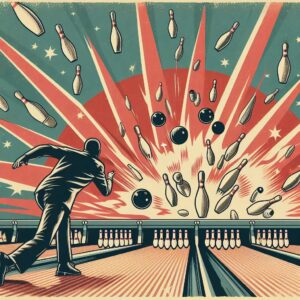Bowling is one of the most popular sports in the world, with over 90 million people participating in leagues annually. Even if you only bowl a few games here and there for fun, improving your bowling skills can be very rewarding.
The difference between a novice bowler and a more advanced one often comes down to having the right techniques and form. With the proper bowling tips, beginners can quickly advance to intermediate levels while more experienced bowlers can master the nuances that lead to high scores.
This complete guide will provide you with 15 expert bowling tips to help refine your game, avoid common mistakes, and knock down more pins with consistency.
From choosing the optimal ball and developing your swing to nailing those tricky splits, these tips will boost your capability and confidence on the lanes.
So grab your ball and bowling shoes and let’s get rolling!
-
Choose the Right Bowling Ball Weight
One of the first steps in improving your bowling game is using the appropriate ball weight. The ideal weight is one that feels comfortable when you swing the ball, allows you to maintain control, and effectively knocks down pins.
The standard guideline is to start with a ball that is 10% of your body weight. However, factors like your fitness level, bowling style, and age should also be considered to find the optimal fit. Heavier balls around 14-16 pounds are common for many adult male players.
When you have the right weight ball in your hands, you should feel balanced while holding it and be able to swing it freely without straining. Your wrist and speed should also stay steady through the pendulum swing.
Testing out different ball weights before buying your own ball is recommended. Ask your bowling alley if they have various demo balls you can try out. The proper ball weight provides a solid foundation for honing all other aspects of your game.
-
Find Your Optimal Bowling Grip
The next key factor that affects ball control, speed, and hook potential is your grip. There are three main types of bowling grips:
- Conventional Grip – Inserts the thumb all the way with medium pressure and balances on the middle and ring finger. Most common grip.
- Fingertip Grip – Thumb inserts halfway with ring and middle finger inserted to first knuckle for more hook potential. Requires more practice to control.
- Two-Handed Grip – Both hands on the ball to generate momentum and revolutions. Less commonly used.
Taking the time to find the grip that works best for you is important. The conventional grip is the easiest for beginners to start with. Those with more experience may prefer a fingertip grip that curls the ball more.
No matter the grip type, you want a snug but relaxed hold on the ball. Gripping too tight can reduce swing control. Test out grips to determine which provides the right balance of comfort, control, and hook ability for your bowling style.
-
Focus on Proper Bowling Form
Having proper form is crucial for accuracy, power, and avoiding injury when bowling. While approaches can vary slightly, there is a basic bowling form to follow:
- Stand with a non-dominant foot forward in a comfortable shoulder-width stance. Keep knees slightly bent.
- Hold the ball at chest level with your arm extended. Use your optimal grip.
- Push the ball forward and take 3-4 steps toward the foul line. The last step is slightly longer.
- Bend the knee of the dominant foot and slide that foot forward as you release the ball.
- Let the ball swing back and then forward like a pendulum. Release the ball close to the ankle.
- Follow through straight toward the target with the arm extended after release.
Practicing this sequence of movements will ingrain muscle memory for consistency. Some common form mistakes to avoid include overextending knees, dropping the ball during backswing, improper release, and off-balance finish. Record yourself to analyze and correct errors.
-
Aim for Consistency in Your Approach
An excellent bowling tip for picking up spares or stringing strikes is to have a consistent pre-shot routine. This entails repeating the same steps in your footwork, alignment, and mental focus each time you step up to bowl.
Performing the same sequence of motions for every shot trains your mind and muscles to replicate successful moves. To improve consistency:
- Start from the same spot on the approach each time.
- Count the same number of steps on each approach.
- Breathe steadily and visualize your shot before releasing it.
- Pick one target arrow on the lane to align with every time.
Drills like bowling with your eyes closed or sliding without the ball also help ingrain an effective timing and footwork rhythm. Consistency leads to accuracy.
-
Tweak Your Throw for More Power
While proper form is essential, another key to knocking down all those pins is generating adequate ball speed and power. Power comes from utilizing the strength in your legs, hips, and arms fluidly as you swing the ball forward.
As you push the ball out, shift weight and bend your dominant leg while straightening the other. Uncoil upwards through your legs to initiate momentum. Then continue motion through hips and shoulders to gain power.
Let gravity bring the ball back before swinging forward. Rolling over your dominant foot, release the ball as you would a pendulum while staying behind the foul line. Follow through towards the target. Maximizing leg drive and swing this way is crucial for bowling power.
Practice sliding and swinging without the ball first to get the feeling. Videotape yourself to review where you may be losing power. Adjust speed as needed – more power for early pins, less for pin carry.
-
Optimize Your Follow-Through
A proper finish position is important both for power transfer and avoiding injury. Allowing momentum to flow fully through the swing keeps the ball on target.
As you release, continue following straight through toward your mark. Resist twisting your body, which risks going off balance. End with weight evenly distributed on both feet, shoulders square, and head still aligned with the target.
Off-balance finishes reduce control and energy transfer. They also increase the risk of straining muscles or falling. Concentrate on maintaining balance through the full finish.
Adjust your follow-through based on shot results. If missing left, finish more upright. If right, lower the stance slightly. Fine-tuning your follow-through takes practice but boosts consistency greatly.
-
Choose the Right Target and Make Adjustments
Selecting the best target arrows on the lane for where you want your ball to go is a valuable bowling strategy. The arrows are the dots or triangles about 15 feet down the lane.
As a beginner, aim for the second arrow from the gutter. Intermediate bowlers can progress to the third arrow. More advanced players use arrows even farther down the lane to optimize strikes.
Once you have an initial target, make small incremental adjustments based on shot results:
- Move feet left and target right if the ball hooks too early.
- Move feet and target left if the ball hooks too late or not enough.
- Move forward on the approach for less hook potential. Move back for more.
Be willing to make minor tweaks to stance, footwork, or ball position between shots to continuously optimize targeting. Don’t be afraid to try new marks on the lane to expand your comfort zone.
-
Develop Strong Spare Shooting Skills
Shooting for spares is equally as important as throwing strikes in order to achieve high bowling scores. A spare converts a two-throw frame into a second strike, doubling your score.
Unfortunately, picking up tricky splits like the 7-10 split or bucket spares requires precision. To improve spare shooting:
- Use a higher ball speed with reduced hook potential.
- Move lateral start position and target line to properly angle at spares.
- Hit your mark or slide! Aim for consistent speed and release point.
- For corner pins, angle ball across the lane off the opposite pocket.
- Visualize hitting the pocket for tough splits. Stay positive!
Practicing shooting drills for various spare combinations improves accuracy and pocket-hitting skills. Spare shooting expertise can rapidly boost scores.
-
Take Advantage of Oil Patterns
Understanding lane oil patterns is another key factor experienced bowlers use to optimize ball reaction and pin carry. Knowing where the oil concentrations are allows you to adjust positioning and throw.
Oil patterns include:
- House Shot – More oil in the middle with drier outsides. Easier to pocket.
- Sport Shot – Flatter oil across the lane. Requires more precision.
- PBA Shot– Complex patterns that favor cranking power.
Observe how your ball reacts across the lane length. Does it slide before hooking sharply? Hold energy for a continuous hook? Or go straight with a minimal curve?
Based on ball motion, move lateral starting positions to find more oil traction or earlier friction as needed. You want the ball to react near the pocket, not too early or late.
-
Maintain Proper Bowling Etiquette
When participating in a bowling league or just casual games, be sure to follow proper bowling etiquette and courtesy rules:
- Wait for bowlers on both sides of you to finish before stepping up.
- Stay off the approach area when others are preparing to bowl.
- Avoid overly loud reactions to avoid distracting others.
- Allow faster bowlers to play through your group if needed.
- Keep walkways clear when bowling or waiting for turns.
- Return house balls promptly and replace them in racks properly.
- Give encouragement, not criticism of other players’ skills.
Following these etiquette guidelines helps ensure a mutually enjoyable bowling experience for everyone.
-
Practice Regularly for Improvement
As with any sport, consistent practice is required to refine skills and engrain proper technique. Try to bowl at least once a week to build muscle memory and comfort. Solo practice helps ingrain fundamentals:
- Do approach drills for optimal footwork.
- Swingball back and forth smoothly without stepping up to improve pendulum motion.
- Practice aligning shoulders and sliding with good knee bend.
During team practices, focus on aspects like timing, power, and targeting. Analyze and correct issues. Don’t just mindlessly bowl – practice with purpose. Increase the difficulty as basics are mastered.
-
Analyze and Make Adjustments
Reviewing each shot or frame to identify needed adjustments is how bowlers evolve their games over time. No two shots or lane conditions are ever exactly the same.
Mentally check foot placement, timing, swing, release, and follow through after each attempt. Did you miss left or right? Overhook or underhook? What minor tweak is needed?
Video recording yourself periodically also helps spot form errors and inconsistencies. Break down positions frame-by-frame if needed to ingrain optimal motions.
Be willing to experiment – move lateral starting positions, change ball angle, adjust targeting, and switch equipment if necessary until finding what works. Careful analysis and adjustment are key for bowling mastery.
-
Invest in Quality Equipment
Having properly fitted equipment designed for your skill level, ball speed, and bowling style affects performance. Don’t just use any old house ball. Key gear to invest in includes:
- Bowling Ball: Get drill-fitted for finger size span and fingertip depth. Choose an appropriate ball weight as well. Select reactive resin coverstock and core shape suited for more hook or a straighter throw. Have pro-shop adjust finger/thumb pitches as needed. Higher-end balls enhance strike percentage.
- Bowling Shoes: Get shoes with interchangeable heels and soles to adjust the slide. Ensure snug fit. Look for microfiber leather uppers for breathability and support. Don’t bowl in street shoes.
- Other accessories like rosin bags, towels, protective tape, gloves, wrist supports, and more aid performance. Quality equipment complements skill development.
-
Prepare Physically Off the Lanes
Bowling well requires not just proper techniques, but also strength, flexibility, and stamina. A strong core, arms, and legs allow the generation of more power and control. Key areas to train include:
- Core: Planks, crunches, medicine ball tosses
- Legs: Squats, lunges, box jumps
- Shoulders: Overhead presses, lateral raises
- Forearms and Wrists: Wrist curls, reverse curls, grippers
Do targeted stretching pre and post-bowling to improve mobility and prevent injury. Stay hydrated and listen to your body. Avoid overexertion. Balance training on and off the lanes.
-
Have Fun!
Above all, remember that bowling should be an enjoyable sport whether competitively or just for leisure. Don’t put too much pressure on yourself. Try these tips for ensuring a fun time bowling:
- Go with family or friends rather than alone.
- Play mini-games within games, like trying to pick up splits.
- Vary throwing styles – two hands, between legs, backward, etc.
- Add some friendly competition and trash talk.
- Celebrate strikes creatively – dances, high fives, chest bumps.
- Take breaks to socialize and eat.
Keeping it lighthearted takes the stress away so you can relax and enjoy bowling more. Don’t dwell on the gutters – focus on fun with friends and continual improvement.
Now Bring Your Bowling Game to the Next Level!
With these 15 expert bowling tips, you now have a complete guide to refine your skills whether you’re a novice or experienced bowler. Finding the right ball, optimizing form, generating power, targeting effectively, and executing with consistency will directly translate into higher scores and flow.
Don’t forget that practice, analysis, quality equipment, and physical preparation also play key roles in upping your bowling prowess. Advance from flinging to firing strikes. Challenge yourself to keep improving. The satisfaction of bowling your best game is unmatched.
Now get out on the lanes and show off your upgraded bowling abilities! I hope this comprehensive set of pro tips gives you the confidence and capability to thrive in bowling. Let me know if have any other advice for excelling at bowling. Here’s to many strikes and spares in your future.
Frequently Asked Questions
What is the trick to bowling?
The main tricks to bowling well are having proper form, consistent release, and aiming for the pocket (between the 1-3 pins for right-handers). Adjusting hand positions and using your legs to generate power also helps increase strikes. Practicing regularly to develop muscle memory is key.
How do you win bowling easily?
Some tips to win at bowling more easily include:
- Use a lighter ball with a fingertip grip to generate more revolutions and pin action
- Visualize your target and ideal ball path. Repeat the same approach each time.
- Make small adjustments to your stance, feet, or release if you miss the pocket.
- Focus on consistency and picking up spares. 10 pins per frame really helps scores.
- Relax and have fun! Taking it seriously often backfires.
How can I improve my bowling?
Ways to improve bowling include lessons from a coach, practicing proper technique regularly, filming yourself to fix errors, investing in your own fitted ball/shoes, strength training your core/legs, analyzing each throw, and learning oil patterns. It takes time but deliberate practice pays off.
Where do you aim in bowling?
For beginners, aim for the 2nd arrow from the gutter if right-handed, 3rd if left-handed. Intermediate bowlers can aim for 3rd arrow, and advanced farther downlane. Adjust your mark based on if you are hooking too early or too late.
Is it better to bowl with a heavier ball?
Not necessarily. The optimal ball weight depends on your strength, comfort level, and control. Generally 10% of body weight is a good starting point. But a lighter ball around 12lbs allows more revs for many bowlers. Find the weight you can swing smoothly and consistently.
What is the fastest way to throw a bowling ball?
For maximum ball speed, use your legs to push off powerfully from the start. Uncoil through hips and straighten your slide leg. Allow gravity to drop the ball on backswing. Release later by adjusting thumb pressure. Follow through fully down lane. But don’t muscle throws – let momentum build.
Should I look at the dots or arrows in bowling?
Focus your eyes on the target arrows about 15 feet down the lane, not the closer dots. The arrows help guide the ball’s direction better. Dots can make you release too early. Keep your head down and commit to the arrow through your follow-through.





